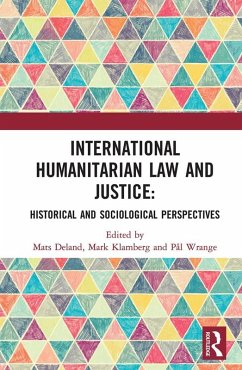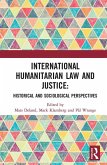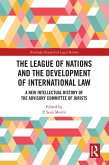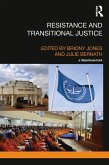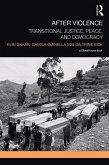International Humanitarian Law and Justice (eBook, ePUB)
Historical and Sociological Perspectives
Redaktion: Deland, Mats; Wrange, Pål; Klamberg, Mark
41,95 €
41,95 €
inkl. MwSt.
Sofort per Download lieferbar

21 °P sammeln
41,95 €
Als Download kaufen

41,95 €
inkl. MwSt.
Sofort per Download lieferbar

21 °P sammeln
Jetzt verschenken
Alle Infos zum eBook verschenken
41,95 €
inkl. MwSt.
Sofort per Download lieferbar
Alle Infos zum eBook verschenken

21 °P sammeln
International Humanitarian Law and Justice (eBook, ePUB)
Historical and Sociological Perspectives
Redaktion: Deland, Mats; Wrange, Pål; Klamberg, Mark
- Format: ePub
- Merkliste
- Auf die Merkliste
- Bewerten Bewerten
- Teilen
- Produkt teilen
- Produkterinnerung
- Produkterinnerung

Bitte loggen Sie sich zunächst in Ihr Kundenkonto ein oder registrieren Sie sich bei
bücher.de, um das eBook-Abo tolino select nutzen zu können.
Hier können Sie sich einloggen
Hier können Sie sich einloggen
Sie sind bereits eingeloggt. Klicken Sie auf 2. tolino select Abo, um fortzufahren.

Bitte loggen Sie sich zunächst in Ihr Kundenkonto ein oder registrieren Sie sich bei bücher.de, um das eBook-Abo tolino select nutzen zu können.
This book brings together scholars from various fields, including law, history, sociology and international relations to examine this historization of international humanitarian law.
- Geräte: eReader
- mit Kopierschutz
- eBook Hilfe
- Größe: 1.51MB
Andere Kunden interessierten sich auch für
![International Humanitarian Law and Justice (eBook, PDF) International Humanitarian Law and Justice (eBook, PDF)]() International Humanitarian Law and Justice (eBook, PDF)41,95 €
International Humanitarian Law and Justice (eBook, PDF)41,95 €![Socialism and Legal History (eBook, ePUB) Socialism and Legal History (eBook, ePUB)]() Socialism and Legal History (eBook, ePUB)0,00 €
Socialism and Legal History (eBook, ePUB)0,00 €![The League of Nations and the Development of International Law (eBook, ePUB) The League of Nations and the Development of International Law (eBook, ePUB)]() The League of Nations and the Development of International Law (eBook, ePUB)43,95 €
The League of Nations and the Development of International Law (eBook, ePUB)43,95 €![Resistance and Transitional Justice (eBook, ePUB) Resistance and Transitional Justice (eBook, ePUB)]() Resistance and Transitional Justice (eBook, ePUB)45,95 €
Resistance and Transitional Justice (eBook, ePUB)45,95 €![The Role of Consent in Human Trafficking (eBook, ePUB) The Role of Consent in Human Trafficking (eBook, ePUB)]() Jessica ElliottThe Role of Consent in Human Trafficking (eBook, ePUB)56,95 €
Jessica ElliottThe Role of Consent in Human Trafficking (eBook, ePUB)56,95 €![After Violence (eBook, ePUB) After Violence (eBook, ePUB)]() Elin SkaarAfter Violence (eBook, ePUB)52,95 €
Elin SkaarAfter Violence (eBook, ePUB)52,95 €![The Scene of the Mass Crime (eBook, ePUB) The Scene of the Mass Crime (eBook, ePUB)]() The Scene of the Mass Crime (eBook, ePUB)43,95 €
The Scene of the Mass Crime (eBook, ePUB)43,95 €-
-
-
This book brings together scholars from various fields, including law, history, sociology and international relations to examine this historization of international humanitarian law.
Dieser Download kann aus rechtlichen Gründen nur mit Rechnungsadresse in A, B, BG, CY, CZ, D, DK, EW, E, FIN, F, GR, HR, H, IRL, I, LT, L, LR, M, NL, PL, P, R, S, SLO, SK ausgeliefert werden.
Produktdetails
- Produktdetails
- Verlag: Taylor & Francis eBooks
- Seitenzahl: 242
- Erscheinungstermin: 18. September 2018
- Englisch
- ISBN-13: 9781351104425
- Artikelnr.: 54256921
- Verlag: Taylor & Francis eBooks
- Seitenzahl: 242
- Erscheinungstermin: 18. September 2018
- Englisch
- ISBN-13: 9781351104425
- Artikelnr.: 54256921
- Herstellerkennzeichnung Die Herstellerinformationen sind derzeit nicht verfügbar.
Mats Deland is Associate Professor in history and temporary lecturer at Mittuniversitet, Sundsvall, Sweden. His publications include Purgatorium (vol. 1, 2010, vol. 2, 2017) and he has expertise in Holocaust studies and Genocide studies, Urban history, Right-Wing Extremism, and the History of International Law. Dr. Mark Klamberg (Jur. Dr. Stockholm University, LL.M. Raoul Wallenberg Institute and Jur. Kand. Lund University) is Associate Professor in international law at Stockholm University. He is the author of several publications on international criminal law, surveillance, privacy, and other fields of international law, including "Evidence in International Criminal Trials: Confronting Legal Gaps and the Reconstruction of Disputed Events" (Martinus Nijhoff Publishers, 2013) and "Power and Law in the International Society - International Relations as the Sociology of International Law" (Routledge, 2015). He is the chief editor of the " Commentary on the Law of the ICC" (CLICC). Pål Wrange (PhD, LL.M) is Professor in public international law at Stockholm University and the Director of the Stockholm Center for International Law and Justice. He is a former principal legal advisor at the Swedish Ministry for Foreign Affairs. He has published widely on international law, international relations and theory and he has worked and consulted for the European Union, governments, and NGOs. He is currently working on a book on non-state actors, right authority, and the right to use military violence.
1: Introduction; 2: PART ONE; 3: Chapter 1 - Introduction; 4: Chapter 2 -
Historicising International Criminal Trials within the Modernist Project;
5: Chapter 3 - Engaging History in the Legal Protection of Cultural
Heritage in War and Peace; 6: Chapter 4 - From Spies to International
Criminals: The Influence of the Austro-Hungarian Counter Espionage Service
on the International Criminal Police Commission; 7: Chapter 5 - Authority,
Legitimacy and Military Violence: De Facto Combatant Privilege of Non-State
Armed Groups through Amnesty; 8: PART TWO; 9: Chapter 1 - Introduction:
Evolution of Rules and Concepts in International Humanitarian Law:
Navigating through Legal Gaps and Fault-lines; 10: Chapter 2 - A hidden
fault-line: How international actors engage with IHL's principle of
distinction; 11: Chapter 3 - Restraint in bello: Some thoughts on
reciprocity and humanity; 12: Chapter 4 - Judging the past - international
humanitarian law and the Luftwaffe aerial operations during the invasion of
Poland in 1939; 13: PART THREE; 14: Chapter 1 - Introduction: Emotions and
the law; 15: Chapter 2 - To feel or not to feel? Emotions and international
humanitarian law To feel or not to feel? Emotions and international
humanitarian law; 16: Chapter 3 - To Kill or Not to Kill as a Social
Question; 17: Chapter 4 - War of Wor(l)ds - Clashing Narratives and
Interpretations of I(H)L in the Intractable Israeli-Palestinian Conflict;
18: PART FOUR; 19: Introduction: The lawyer as an actor in history and
society; 20: Chapter 2 - Lemkin on vandalism and the protection of cultural
works and historical monuments during armed conflict; 21: Chapter 3 -
Forgotten, but nevertheless relevant! Gustave Moynier's attempts to punish
violations of the laws of war 1870-1916; 22: Chapter 4 - The feminist
origins of the Swedish Red Cross; 23: Index
Historicising International Criminal Trials within the Modernist Project;
5: Chapter 3 - Engaging History in the Legal Protection of Cultural
Heritage in War and Peace; 6: Chapter 4 - From Spies to International
Criminals: The Influence of the Austro-Hungarian Counter Espionage Service
on the International Criminal Police Commission; 7: Chapter 5 - Authority,
Legitimacy and Military Violence: De Facto Combatant Privilege of Non-State
Armed Groups through Amnesty; 8: PART TWO; 9: Chapter 1 - Introduction:
Evolution of Rules and Concepts in International Humanitarian Law:
Navigating through Legal Gaps and Fault-lines; 10: Chapter 2 - A hidden
fault-line: How international actors engage with IHL's principle of
distinction; 11: Chapter 3 - Restraint in bello: Some thoughts on
reciprocity and humanity; 12: Chapter 4 - Judging the past - international
humanitarian law and the Luftwaffe aerial operations during the invasion of
Poland in 1939; 13: PART THREE; 14: Chapter 1 - Introduction: Emotions and
the law; 15: Chapter 2 - To feel or not to feel? Emotions and international
humanitarian law To feel or not to feel? Emotions and international
humanitarian law; 16: Chapter 3 - To Kill or Not to Kill as a Social
Question; 17: Chapter 4 - War of Wor(l)ds - Clashing Narratives and
Interpretations of I(H)L in the Intractable Israeli-Palestinian Conflict;
18: PART FOUR; 19: Introduction: The lawyer as an actor in history and
society; 20: Chapter 2 - Lemkin on vandalism and the protection of cultural
works and historical monuments during armed conflict; 21: Chapter 3 -
Forgotten, but nevertheless relevant! Gustave Moynier's attempts to punish
violations of the laws of war 1870-1916; 22: Chapter 4 - The feminist
origins of the Swedish Red Cross; 23: Index
1: Introduction; 2: PART ONE; 3: Chapter 1 - Introduction; 4: Chapter 2 -
Historicising International Criminal Trials within the Modernist Project;
5: Chapter 3 - Engaging History in the Legal Protection of Cultural
Heritage in War and Peace; 6: Chapter 4 - From Spies to International
Criminals: The Influence of the Austro-Hungarian Counter Espionage Service
on the International Criminal Police Commission; 7: Chapter 5 - Authority,
Legitimacy and Military Violence: De Facto Combatant Privilege of Non-State
Armed Groups through Amnesty; 8: PART TWO; 9: Chapter 1 - Introduction:
Evolution of Rules and Concepts in International Humanitarian Law:
Navigating through Legal Gaps and Fault-lines; 10: Chapter 2 - A hidden
fault-line: How international actors engage with IHL's principle of
distinction; 11: Chapter 3 - Restraint in bello: Some thoughts on
reciprocity and humanity; 12: Chapter 4 - Judging the past - international
humanitarian law and the Luftwaffe aerial operations during the invasion of
Poland in 1939; 13: PART THREE; 14: Chapter 1 - Introduction: Emotions and
the law; 15: Chapter 2 - To feel or not to feel? Emotions and international
humanitarian law To feel or not to feel? Emotions and international
humanitarian law; 16: Chapter 3 - To Kill or Not to Kill as a Social
Question; 17: Chapter 4 - War of Wor(l)ds - Clashing Narratives and
Interpretations of I(H)L in the Intractable Israeli-Palestinian Conflict;
18: PART FOUR; 19: Introduction: The lawyer as an actor in history and
society; 20: Chapter 2 - Lemkin on vandalism and the protection of cultural
works and historical monuments during armed conflict; 21: Chapter 3 -
Forgotten, but nevertheless relevant! Gustave Moynier's attempts to punish
violations of the laws of war 1870-1916; 22: Chapter 4 - The feminist
origins of the Swedish Red Cross; 23: Index
Historicising International Criminal Trials within the Modernist Project;
5: Chapter 3 - Engaging History in the Legal Protection of Cultural
Heritage in War and Peace; 6: Chapter 4 - From Spies to International
Criminals: The Influence of the Austro-Hungarian Counter Espionage Service
on the International Criminal Police Commission; 7: Chapter 5 - Authority,
Legitimacy and Military Violence: De Facto Combatant Privilege of Non-State
Armed Groups through Amnesty; 8: PART TWO; 9: Chapter 1 - Introduction:
Evolution of Rules and Concepts in International Humanitarian Law:
Navigating through Legal Gaps and Fault-lines; 10: Chapter 2 - A hidden
fault-line: How international actors engage with IHL's principle of
distinction; 11: Chapter 3 - Restraint in bello: Some thoughts on
reciprocity and humanity; 12: Chapter 4 - Judging the past - international
humanitarian law and the Luftwaffe aerial operations during the invasion of
Poland in 1939; 13: PART THREE; 14: Chapter 1 - Introduction: Emotions and
the law; 15: Chapter 2 - To feel or not to feel? Emotions and international
humanitarian law To feel or not to feel? Emotions and international
humanitarian law; 16: Chapter 3 - To Kill or Not to Kill as a Social
Question; 17: Chapter 4 - War of Wor(l)ds - Clashing Narratives and
Interpretations of I(H)L in the Intractable Israeli-Palestinian Conflict;
18: PART FOUR; 19: Introduction: The lawyer as an actor in history and
society; 20: Chapter 2 - Lemkin on vandalism and the protection of cultural
works and historical monuments during armed conflict; 21: Chapter 3 -
Forgotten, but nevertheless relevant! Gustave Moynier's attempts to punish
violations of the laws of war 1870-1916; 22: Chapter 4 - The feminist
origins of the Swedish Red Cross; 23: Index
